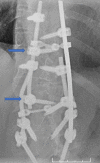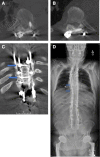Fusion Mass Screws in Revision Spinal Deformity Surgery: A Simple and Safe Alternative Fixation
- PMID: 35918142
- PMCID: PMC10025832
- DOI: 10.14444/8352
Fusion Mass Screws in Revision Spinal Deformity Surgery: A Simple and Safe Alternative Fixation
Abstract
Background: Revision spinal deformity surgery has a high rate of complications. Fixation may be challenging due to altered anatomy. Screws through a fusion mass are an alternative to pedicle screw fixation.
Objective: The purpose of this retrospective study was to further elucidate the safety and efficacy of fusion mass screws (FMSs) in revision spinal deformity surgery.
Design: Retrospective case series.
Methods: Fifteen freehand FMSs were placed in 6 patients with adult spinal deformity between 2016 and 2018 by the senior author. FMSs were combined with pedicle screws, at times at the same level. FMSs were used to save distal levels from fusion, assist in closing a 3-column osteotomy and provide additional fixation in cases of severe instability. Computed tomography (CT) was used to assess bone mineral density (BMD) and thickness of each fusion mass preoperatively along with accuracy of FMS placement postoperatively.
Results: The mean BMD of the fusion mass was 397 Hounsfield units (HU; range: 156-628 HU). The mean AP thickness of the fusion mass was 15.5 ± 4.8 mm (range: 8.6-24.4 mm). The mean FMS length was 35.3 ± 5.5 mm (range: 25-40 mm). There was no evidence of FMS loosening, breakage, or pseudarthrosis at latest follow-up (mean: 2.2 years, range: 1.4-3.1 years). No neurologic deficits were observed. 1/15 screws had a low-grade breach into the canal (<2 mm). No patients required revision surgery.
Conclusion: FMSs may be used to augment fixation in revision spinal deformity cases when pedicle screw placement may be challenging. FMSs may also provide an additional anchor at levels with pedicular fixation.
Keywords: extrapedicular fixation; fusion mass; pedicular dysplasia; revision; spinal deformity.
This manuscript is generously published free of charge by ISASS, the International Society for the Advancement of Spine Surgery. Copyright © 2023 ISASS. To see more or order reprints or permissions, see http://ijssurgery.com.
Conflict of interest statement
Declaration of Conflicting Interests: Dimitriy G. Kondrashov reports receiving royalties and consulting fees from Spineart. The remaining authors have no relevant or material financial interests that relate to the research described in this paper.
Figures







References
-
- Rampersaud YR, Lee KS. Fluoroscopic computer-assisted pedicle screw placement through a mature fusion mass: an assessment of 24 consecutive cases with independent analysis of computed tomography and clinical data. Spine (Phila Pa 1976). 2007;32(2):217–222. 10.1097/01.brs.0000251751.51936.3f - DOI - PubMed
LinkOut - more resources
Full Text Sources
Miscellaneous
